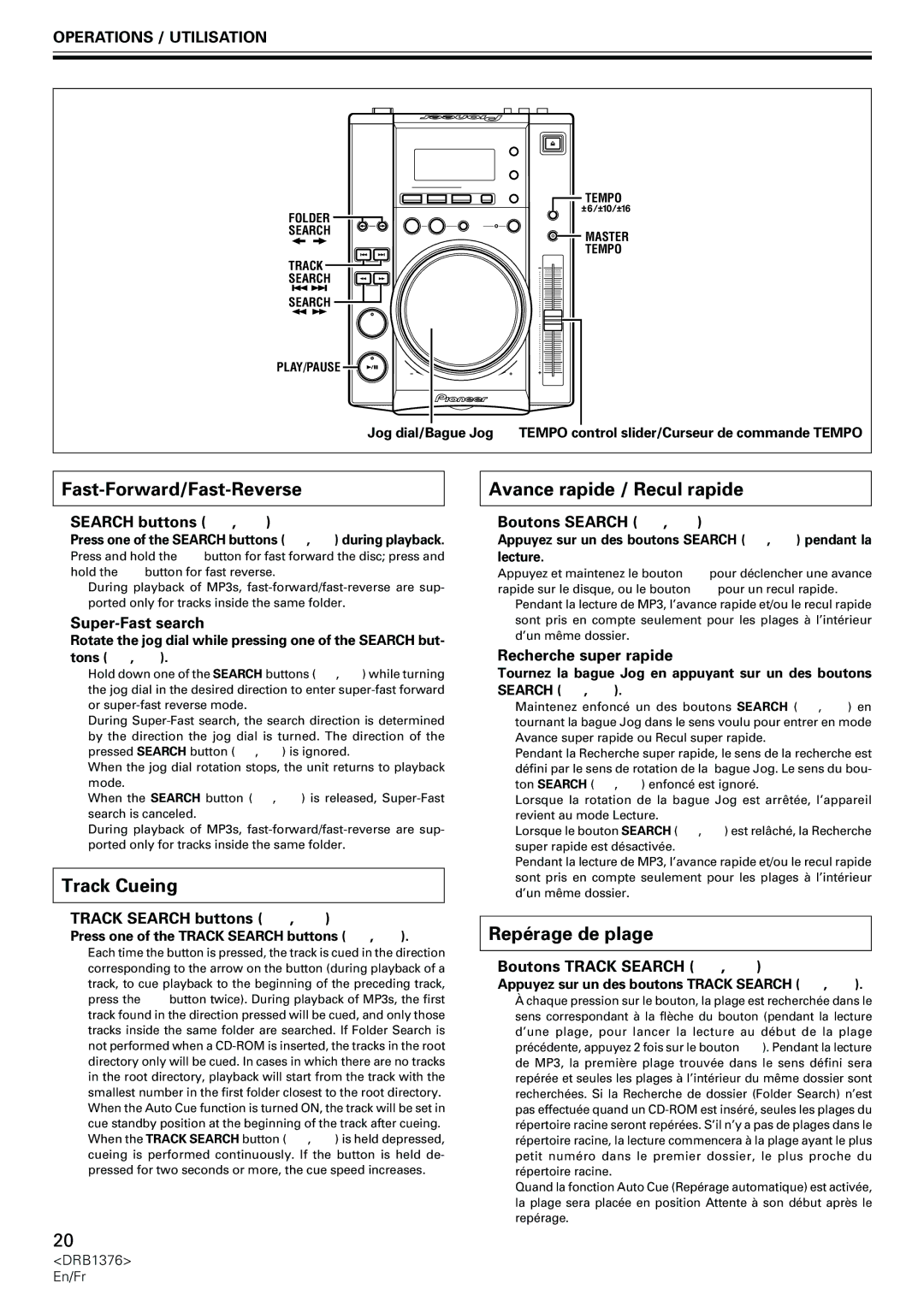
OPERATIONS / UTILISATION
FOLDER
SEARCH
TRACK
SEARCH
SEARCH
PLAY/PAUSE ![]()
![]()
![]()
![]()
![]() TEMPO
TEMPO
![]() MASTER TEMPO
MASTER TEMPO
Jog dial/Bague Jog TEMPO control slider/Curseur de commande TEMPO
Fast-Forward/Fast-Reverse
7SEARCH buttons (1, ¡)
Press one of the SEARCH buttons (1, ¡) during playback.
Press and hold the ¡ button for fast forward the disc; press and hold the 1 button for fast reverse.
¶During playback of MP3s,
7
Rotate the jog dial while pressing one of the SEARCH but- tons (1, ¡).
¶Hold down one of the SEARCH buttons (1, ¡) while turning the jog dial in the desired direction to enter
¶During
¶When the jog dial rotation stops, the unit returns to playback mode.
¶When the SEARCH button (1, ¡) is released,
¶During playback of MP3s,
Track Cueing
7TRACK SEARCH buttons (4, ¢)
Press one of the TRACK SEARCH buttons (4, ¢).
¶Each time the button is pressed, the track is cued in the direction corresponding to the arrow on the button (during playback of a track, to cue playback to the beginning of the preceding track, press the 4 button twice). During playback of MP3s, the first track found in the direction pressed will be cued, and only those tracks inside the same folder are searched. If Folder Search is not performed when a
¶When the Auto Cue function is turned ON, the track will be set in cue standby position at the beginning of the track after cueing.
¶When the TRACK SEARCH button (4, ¢) is held depressed, cueing is performed continuously. If the button is held de- pressed for two seconds or more, the cue speed increases.
Avance rapide / Recul rapide
7Boutons SEARCH (1, ¡)
Appuyez sur un des boutons SEARCH (1, ¡) pendant la
lecture.
Appuyez et maintenez le bouton ¡ pour déclencher une avance rapide sur le disque, ou le bouton 1 pour un recul rapide.
¶Pendant la lecture de MP3, l’avance rapide et/ou le recul rapide sont pris en compte seulement pour les plages à l’intérieur d’un même dossier.
7Recherche super rapide
Tournez la bague Jog en appuyant sur un des boutons SEARCH (1, ¡).
¶Maintenez enfoncé un des boutons SEARCH (1, ¡) en tournant la bague Jog dans le sens voulu pour entrer en mode Avance super rapide ou Recul super rapide.
¶Pendant la Recherche super rapide, le sens de la recherche est défini par le sens de rotation de la bague Jog. Le sens du bou- ton SEARCH (1, ¡) enfoncé est ignoré.
¶Lorsque la rotation de la bague Jog est arrêtée, l’appareil revient au mode Lecture.
¶Lorsque le bouton SEARCH (1, ¡) est relâché, la Recherche super rapide est désactivée.
¶Pendant la lecture de MP3, l’avance rapide et/ou le recul rapide sont pris en compte seulement pour les plages à l’intérieur d’un même dossier.
Repérage de plage
7Boutons TRACK SEARCH (4, ¢)
Appuyez sur un des boutons TRACK SEARCH (4, ¢).
¶À chaque pression sur le bouton, la plage est recherchée dans le sens correspondant à la flèche du bouton (pendant la lecture d’une plage, pour lancer la lecture au début de la plage précédente, appuyez 2 fois sur le bouton 4). Pendant la lecture de MP3, la première plage trouvée dans le sens défini sera repérée et seules les plages à l’intérieur du même dossier sont recherchées. Si la Recherche de dossier (Folder Search) n’est pas effectuée quand un
¶Quand la fonction Auto Cue (Repérage automatique) est activée, la plage sera placée en position Attente à son début après le repérage.
20
<DRB1376>
En/Fr
